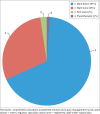Pain assessment and management: An audit of practice at a tertiary hospital
- PMID: 32161673
- PMCID: PMC7059650
- DOI: 10.4102/hsag.v25i0.1281
Pain assessment and management: An audit of practice at a tertiary hospital
Abstract
Background: In spite of advances in techniques and analgesics for pain management, pain remains a major health problem. Regular assessment and reassessment of pain using guidelines with measurable goals is essential for effective pain management in surgical wards. Unfortunately, no such guidelines exist in South Africa. To implement appropriate precepts for the South African context, the current practice must be understood.
Aim: The aim of this article was to evaluate pain assessment and management of patients in two surgical wards at a tertiary hospital in South Africa.
Setting: The study was conducted within the Western Cape Province of South Africa in a government-funded tertiary academic institution. The patients at this hospital are generally from the low-income strata and live in resource-poor communities.
Methods: A cross-sectional, retrospective medical record audit was conducted. The folders of all 215 patients admitted to a specific orthopaedic trauma and urogynaecological ward of a tertiary hospital in South Africa over a span of 1 month were targeted for review. Medical folders that were not available or had missing notes were excluded. Variables evaluated included the number of pain assessments recorded, pain assessor, assessment tool and management plan.
Results: A total of 168 folders were available for review. Nearly half of the patients had no documented pain assessment. The Verbal Rating Scale was the predominant tool used, and assessments were mostly conducted by the ward doctor. Pain interventions appeared to be primarily based on the professional knowledge of the practitioner and were not evidence-based.
Conclusion: Pain assessment and management was a problem in the two wards reviewed, which is similar to the findings from studies referenced in this text. Health professionals must be empowered to manage pain adequately. An assessment tool that integrates the biopsychosocial factors that influence the pain experience should be routinely employed by a multidisciplinary team to facilitate goal-directed therapy.
Keywords: South Africa; assessment; management; pain; perioperative.
© 2020. The Authors.
Conflict of interest statement
The authors have declared that no competing interest exist.
Figures
References
-
- Chanvej L., Petpichetchian W., Kovitwanawong N., Chaibandit C., Vorakul C. & Khunthong T., 2004, ‘A chart audit of postoperative pain assessment and documentation: The first step to implement pain assessment as the fifth vital sign in a University Hospital in Thailand’, Journal of the Medical Association of Thailand 87(12), 1447–1453. - PubMed
-
- Chou R., Gordon D.B., De Leon-Casasola O.A., Rosenberg J.M., Bickler S., Brennan T. et al. , 2016, ‘Management of postoperative pain: A clinical practice guideline from the American Pain Society, the American Society of Regional Anesthesia and Pain Medicine, and the American Society of Anesthesiologists’ Committee on Regional Anesthesia, Executive Committee, and Administrative Council’, Journal of Pain 17(2), 131–157. 10.1016/j.jpain.2015.12.008 - DOI - PubMed
LinkOut - more resources
Full Text Sources


